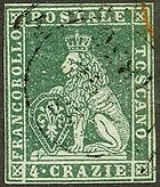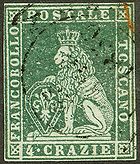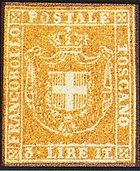
Postage stamps and postal history of Tuscany
Encyclopedia
Between 1851 and 1860, Grand Duchy of Tuscany
, an independent Italian state until 1859 when it joined the United Provinces of Central Italy
, produced two postage stamp issues which are among the most prized classic stamp
issues of the world, and include the most valuable Italian stamp.
from 1808 to 1814. The Duchy comprised most of the present area of Tuscany
, and its capital was Florence
. In December 1859, the Grand Duchy officially ceased to exist, being joined to the Duchies of Modena and Parma
to form the United Provinces of Central Italy, which was annexed by the Kingdom of Sardinia
a few months later in March 1860.
In 1862 it became part of Italy.
and Livorno
.
Prior to the introduction of postage stamps in 1851, letters typically were sent postage due, with various postal markings added to the letter. Postal markings were originally hand written on the letters, and in about 1767, postal markings began to be added by rubber stamp, indicating the town of origin. In 1839, postal markings were introduced indicating the date the letter was mailed. Tuscany's pre-stamp letters and postal markings have received extensive philatelic study
. The primary study of them is Paolo Vollmeier's I Bolli Postali Toscani del Periodo Prefilatelico fino al 1851, Florence, 1974.
and on April 8, 1839, it signed a similar agreement with Austria
. These agreements regulated postal rates and procedures for transporting mail between the countries.
Another postal convention between Tuscany and Austria was signed on December 1850, which addressed the exchange of mail between the countries and contemplated the introduction of adhesive stamps.Postal conventions with Sardinia and France were entered into in 1851.
 On April 1, 1851, Tuscany issued its first adhesive postage stamps. The stamps depict a crowned lion resting a paw on a shield with the fleur-de-lis. The image is based on the Renaissance sculpture by Donatello
On April 1, 1851, Tuscany issued its first adhesive postage stamps. The stamps depict a crowned lion resting a paw on a shield with the fleur-de-lis. The image is based on the Renaissance sculpture by Donatello
of a lion called the Marzocco
which was originally commissioned for Pope Martin V
and moved in 1812 to the Piazza della Signoria
in Florence where it became a symbol of Florentine liberties. The stamps shared a common design, differing only in color and denomination. The stamps were initially issued in denominations of 1 and 2 soldi, and 2, 4 and 6 crazie. In July 1851, 1 and 9 crazie stamps were issued and in 1852, Tuscany introduced a 1 quattrino
for mailing newspapers and a 60 crazie stamp for international use. The Tuscan lira was divided into 12 crazie, or 20 soldi or 60 quattrini.
These stamps were printed by typography
by F. Cambiagi at the Grand Ducal Printing Office in Florence. The stamps were engraved by Giuseppe Niderost from which electrotypes
were prepared by M. Alessandri of Florence. The stamps were imperforate and were printed in sheets of 240 subjects divided into three panes of 80 stamps each. The paper was lightly toned blue or gray and was watermarked
with rows of the Crown of Tuscany between parallel lines.
Between 1857 and 1859, the stamps, other than the 2 soldi and 60 crazie values, were reissued in the same or similar colors, but printed on white paper with a watermark with intersecting curved lozenges and the words "II E RR POSTE TOSCANE". These, like the prior issue, were typographed, imperforate and printed in sheets of 240 subjects divided into three panes of 80 stamps each.
 Grand Duke Leopold II
Grand Duke Leopold II
abdicated on July 21, 1859, and was succeeded by his son, Ferdinand IV
, who was deposed after 27 days. Tuscany briefly became part of the United Provinces of Central Italy, a short-lived client state of the Kingdom of Piedmont-Sardinia, which resulted in Sardinian currency being introduced in which one lira was divided into 100 centesimi. On 7 November 1859, the United Provinces elected Eugenio Emanuele di Savoia-Carignano as their regent. A new series of provisional stamps
was issued on January 1, 1860, using the same border, but the lion was replaced with the arms of the House of Savoy
. Like the prior two issues, these stamps were typographed, imperforate and printed in sheets of 240 subjects divided into three panes of 80 stamps each. In March 1860, Tuscany was annexed to Sardinia, after which Tuscany used the stamps of Sardinia, and in 1862, Italy.
Tuscany's postage stamps are among the most highly prized and collected classic stamps
and have been extensively studied by philatelists. The primary study on them is F. Bargagli Petrucci's I Bolli Postali Toscani del Periodo Filatelico dal 1851 (1976). The three lire stamp of the 1860 issue in mint condition is the most valuable Italian stamp.
 Tuscany's postage stamps have been forged
Tuscany's postage stamps have been forged
numerous times for the philatelic market. Fernand Serrane
stated in 1927 that "a small book would be needed to describe in detail the more than 100 or so counterfeits of the first two Tuscany issues."
Grand Duchy of Tuscany
The Grand Duchy of Tuscany was a central Italian monarchy that existed, with interruptions, from 1569 to 1859, replacing the Duchy of Florence. The grand duchy's capital was Florence...
, an independent Italian state until 1859 when it joined the United Provinces of Central Italy
United Provinces of Central Italy
The United Provinces of Central Italy, also known as Union of Central Italy, Confederation of Central Italy or Government General of Central Italy, was a short-lived client state of the Kingdom of Piedmont-Sardinia...
, produced two postage stamp issues which are among the most prized classic stamp
Classic stamp
A classic stamp is a postage stamp of a type considered distinctive by philatelists, typically applied to stamps printed in the early period of stamp production, e.g., before about 1870. However, as L. N. Williams puts it, "the term has never been satisfactorily defined"...
issues of the world, and include the most valuable Italian stamp.
Tuscany's modern history
The Grand Duchy of Tuscany was an independent Italian state from 1569 to 1859, but was occupied by FranceFrance
The French Republic , The French Republic , The French Republic , (commonly known as France , is a unitary semi-presidential republic in Western Europe with several overseas territories and islands located on other continents and in the Indian, Pacific, and Atlantic oceans. Metropolitan France...
from 1808 to 1814. The Duchy comprised most of the present area of Tuscany
Tuscany
Tuscany is a region in Italy. It has an area of about 23,000 square kilometres and a population of about 3.75 million inhabitants. The regional capital is Florence ....
, and its capital was Florence
Florence
Florence is the capital city of the Italian region of Tuscany and of the province of Florence. It is the most populous city in Tuscany, with approximately 370,000 inhabitants, expanding to over 1.5 million in the metropolitan area....
. In December 1859, the Grand Duchy officially ceased to exist, being joined to the Duchies of Modena and Parma
Duchy of Parma
The Duchy of Parma was created in 1545 from that part of the Duchy of Milan south of the Po River, as a fief for Pope Paul III's illegitimate son, Pier Luigi Farnese, centered on the city of Parma....
to form the United Provinces of Central Italy, which was annexed by the Kingdom of Sardinia
Kingdom of Sardinia
The Kingdom of Sardinia consisted of the island of Sardinia first as a part of the Crown of Aragon and subsequently the Spanish Empire , and second as a part of the composite state of the House of Savoy . Its capital was originally Cagliari, in the south of the island, and later Turin, on the...
a few months later in March 1860.
In 1862 it became part of Italy.
Pre stamp letters
Tuscany's mail service may be traced to private letter services operating between 1300 and 1400. In 1704, Gian Gastone de' Medici issued a decree converting the postal service to a state operation and regulating the posting, transport and delivery of letters in detail. The original service ran only between Florence, PisaPisa
Pisa is a city in Tuscany, Central Italy, on the right bank of the mouth of the River Arno on the Tyrrhenian Sea. It is the capital city of the Province of Pisa...
and Livorno
Livorno
Livorno , traditionally Leghorn , is a port city on the Tyrrhenian Sea on the western edge of Tuscany, Italy. It is the capital of the Province of Livorno, having a population of approximately 160,000 residents in 2009.- History :...
.
Prior to the introduction of postage stamps in 1851, letters typically were sent postage due, with various postal markings added to the letter. Postal markings were originally hand written on the letters, and in about 1767, postal markings began to be added by rubber stamp, indicating the town of origin. In 1839, postal markings were introduced indicating the date the letter was mailed. Tuscany's pre-stamp letters and postal markings have received extensive philatelic study
Philately
Philately is the study of stamps and postal history and other related items. Philately involves more than just stamp collecting, which does not necessarily involve the study of stamps. It is possible to be a philatelist without owning any stamps...
. The primary study of them is Paolo Vollmeier's I Bolli Postali Toscani del Periodo Prefilatelico fino al 1851, Florence, 1974.
Postal treaties
On December 31, 1838, Tuscany signed a postal agreement with the Kingdom of SardiniaKingdom of Sardinia
The Kingdom of Sardinia consisted of the island of Sardinia first as a part of the Crown of Aragon and subsequently the Spanish Empire , and second as a part of the composite state of the House of Savoy . Its capital was originally Cagliari, in the south of the island, and later Turin, on the...
and on April 8, 1839, it signed a similar agreement with Austria
Austria
Austria , officially the Republic of Austria , is a landlocked country of roughly 8.4 million people in Central Europe. It is bordered by the Czech Republic and Germany to the north, Slovakia and Hungary to the east, Slovenia and Italy to the south, and Switzerland and Liechtenstein to the...
. These agreements regulated postal rates and procedures for transporting mail between the countries.
Another postal convention between Tuscany and Austria was signed on December 1850, which addressed the exchange of mail between the countries and contemplated the introduction of adhesive stamps.Postal conventions with Sardinia and France were entered into in 1851.
Il Marzocco

Donatello
Donato di Niccolò di Betto Bardi , also known as Donatello, was an early Renaissance Italian artist and sculptor from Florence...
of a lion called the Marzocco
Marzocco
The Marzocco is the heraldic lion, best known in the rendition sculpted by Donatello in 1418–20, that is a symbol of Florence.Donatello's Marzocco was commissioned by the Republic of Florence for the apartment of Pope Martin V at Santa Maria Novella, where this traditional insegna of...
which was originally commissioned for Pope Martin V
Pope Martin V
Pope Martin V , born Odo Colonna, was Pope from 1417 to 1431. His election effectively ended the Western Schism .-Biography:...
and moved in 1812 to the Piazza della Signoria
Piazza della Signoria
Piazza della Signoria is an L-shaped square in front of the Palazzo Vecchio in Florence, Italy. It was named after the Palazzo della Signoria, also called Palazzo Vecchio....
in Florence where it became a symbol of Florentine liberties. The stamps shared a common design, differing only in color and denomination. The stamps were initially issued in denominations of 1 and 2 soldi, and 2, 4 and 6 crazie. In July 1851, 1 and 9 crazie stamps were issued and in 1852, Tuscany introduced a 1 quattrino
Quattrino
The quattrino is an ancient Italian currency denomination largely used in Central Italy, especially in Tuscany. Its name derives from the latin quater denari, because its value was equal to four denari. Consequently, its value was one third of a soldo...
for mailing newspapers and a 60 crazie stamp for international use. The Tuscan lira was divided into 12 crazie, or 20 soldi or 60 quattrini.
These stamps were printed by typography
Typography
Typography is the art and technique of arranging type in order to make language visible. The arrangement of type involves the selection of typefaces, point size, line length, leading , adjusting the spaces between groups of letters and adjusting the space between pairs of letters...
by F. Cambiagi at the Grand Ducal Printing Office in Florence. The stamps were engraved by Giuseppe Niderost from which electrotypes
Electrotyping
Electrotyping is a chemical method for forming metal parts that exactly reproduce a model. The method was invented by Moritz von Jacobi in Russia in 1838, and was immediately adopted for applications in printing and several other fields...
were prepared by M. Alessandri of Florence. The stamps were imperforate and were printed in sheets of 240 subjects divided into three panes of 80 stamps each. The paper was lightly toned blue or gray and was watermarked
Watermark
A watermark is a recognizable image or pattern in paper that appears as various shades of lightness/darkness when viewed by transmitted light , caused by thickness or density variations in the paper...
with rows of the Crown of Tuscany between parallel lines.
Between 1857 and 1859, the stamps, other than the 2 soldi and 60 crazie values, were reissued in the same or similar colors, but printed on white paper with a watermark with intersecting curved lozenges and the words "II E RR POSTE TOSCANE". These, like the prior issue, were typographed, imperforate and printed in sheets of 240 subjects divided into three panes of 80 stamps each.
Arms of Savoy

Leopold II, Grand Duke of Tuscany
Leopold II of Tuscany was the last reigning grand duke of Tuscany ....
abdicated on July 21, 1859, and was succeeded by his son, Ferdinand IV
Ferdinand IV, Grand Duke of Tuscany
Ferdinand IV, Grand Duke of Tuscany was the last Grand Duke of Tuscany from 1859 to 1860. The House of Habsburg-Lorraine continued to hold the title as pretenders until the end of World War I.-Biography:...
, who was deposed after 27 days. Tuscany briefly became part of the United Provinces of Central Italy, a short-lived client state of the Kingdom of Piedmont-Sardinia, which resulted in Sardinian currency being introduced in which one lira was divided into 100 centesimi. On 7 November 1859, the United Provinces elected Eugenio Emanuele di Savoia-Carignano as their regent. A new series of provisional stamps
Provisional stamp
Linn's World Stamp Almanac defines a provisional stamp as "a postage stamp issued for temporary use to meet postal demands until new or regular stocks of stamps can be obtained."...
was issued on January 1, 1860, using the same border, but the lion was replaced with the arms of the House of Savoy
House of Savoy
The House of Savoy was formed in the early 11th century in the historical Savoy region. Through gradual expansion, it grew from ruling a small county in that region to eventually rule the Kingdom of Italy from 1861 until the end of World War II, king of Croatia and King of Armenia...
. Like the prior two issues, these stamps were typographed, imperforate and printed in sheets of 240 subjects divided into three panes of 80 stamps each. In March 1860, Tuscany was annexed to Sardinia, after which Tuscany used the stamps of Sardinia, and in 1862, Italy.
Tuscany's postage stamps are among the most highly prized and collected classic stamps
Classic stamp
A classic stamp is a postage stamp of a type considered distinctive by philatelists, typically applied to stamps printed in the early period of stamp production, e.g., before about 1870. However, as L. N. Williams puts it, "the term has never been satisfactorily defined"...
and have been extensively studied by philatelists. The primary study on them is F. Bargagli Petrucci's I Bolli Postali Toscani del Periodo Filatelico dal 1851 (1976). The three lire stamp of the 1860 issue in mint condition is the most valuable Italian stamp.
Forgeries

Philatelic fakes and forgeries
In general, philatelic fakes and forgeries refers to labels that look like postage stamps but are not. Most have been produced to deceive or defraud...
numerous times for the philatelic market. Fernand Serrane
Fernand Serrane
Fernand Serrane was a Belgian philatelist who was a popular philatelic author in France and published one of the classic works in the field of identifying forged stamps.- Masterwork :...
stated in 1927 that "a small book would be needed to describe in detail the more than 100 or so counterfeits of the first two Tuscany issues."

